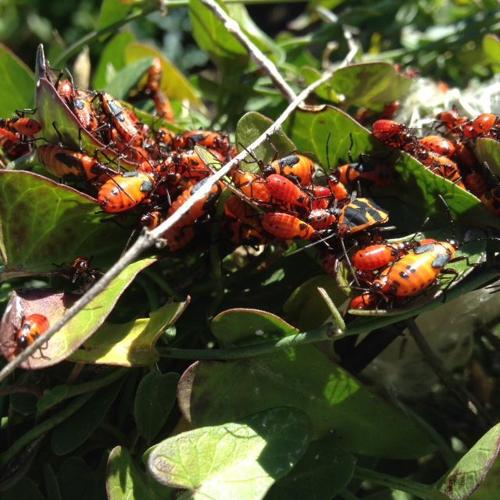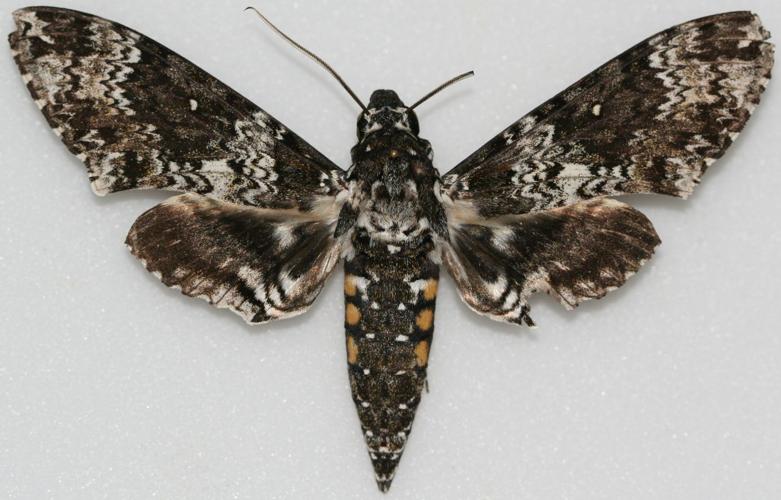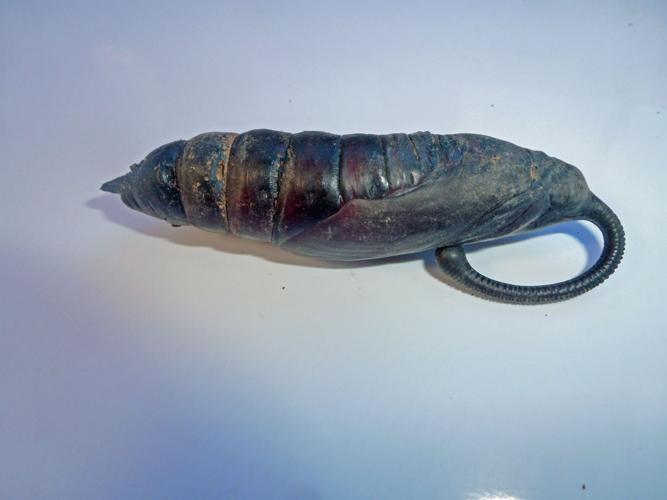Q: I saw lots of these bugs at the community garden this morning. They are massed on the open pods of a vine-like plant that has grown up the chain-link fence. The pods are about 3 inches long, brown-gray, and with with a tail or point. When open, they release a mass of cotton-like fluff. What the heck are these?
A: They are milkweed bugs (Oncopeltus fasciatus), and the plant is climbing milkweed vine (Funastrum cynanchoides). In the photo you sent, I see mostly nymphs. These young bugs do not have fully developed wings. Instead, they show wing buds, the two small, black, miniature, wing-shaped parts on their backs. There is one adult in the photo, showing fully developed wings with a black stripe across the middle of the body.
Like monarch and queen butterfly larvae, these milkweed bugs are protected from predators by ingesting the milky sap from this plant. The sap contains cardiac glycosides that can harm predators. Their red color gives the warning to potential predators that they are hazardous.
Since these insects stick with that plant, and that plant is probably not what you are growing in your community garden on purpose, what you do about them is a matter of preference. Some consider the milkweed a weed, while others like to attract butterflies.
Q: We are rejuvenating an in-ground garden, the Desert Meadows Park in Green Valley, to create a demonstration garden for folks with limited space, resources and physical limitations. The bed we were given has a major grub infestation. Any information on how to manage the grubs would be appreciated. The Green Valley Garden Club’s website has a good section on the Desert Meadows Park.
A: I visited the Desert Meadows Park during a recent trip to Green Valley. It’s a very nice place, and you all have done a great job with it. Grubs are always a potential problem, but sometimes not a big deal. There are a wide variety of beetle grubs we might find in a garden. Common types are the whitish, C-shaped scarab beetles.
There are a few species in this family you might find, so identifying the species is helpful, and counting the number you find per square foot is how we determine if treatment is necessary. Often in a garden plot, you can manually remove them and feed them to your chickens or toss them into an open area where other birds are likely to find them.
Identification of scarab grubs is based on the size sometimes, and examining the back end for patterns of hairs. Not everyone likes to get that close to the butt end of a grub, so I can help if needed. Once you know the identity, the life-cycle information will help determine the host plants they feed on and when the best time of year is to manage them.
Q: We’ve had this guy around for the last few days. What is he? A luna moth perhaps? What should we look for in coming days?
A: It’s a hornworm, Manduca rustica (aka rustic sphinx moth), to be precise. They are commonly seen crawling around this time of year looking for a place to pupate in the soil. They are basically harmless and not considered a pest species.
The adult moth might not emerge until spring, and they fly at night, so the adults aren’t seen as often as the caterpillars. The luna moth (Actias luna) is one of my favorites, and is found east of the Great Plains, so I am guessing you lived elsewhere once upon a time.
Q: I found the cocoon featured in the attached photo; not sure what it is. Can you ID it for me and describe its adult form? It’s fun living out in the Amado countryside; strange things come around almost daily.
A: Your pupa is that of a hornworm, a sphinx-moth-to-be. They have a very distinct shape, as you can see, and you can probably make out the shape of their wings imprinted on the side.
There are many species of hornworms, or sphinx moths. Some of the most common and recognizable are the tomato and tobacco hornworms that eat our tomato plants in the garden.
I suspect yours is one of those two, and you can keep it comfortable until it emerges to find out. We also tend to see a lot of white-lined sphinx moths, because they fly during the day and act a bit like hummingbirds when they visit flowers to consume nectar.
They are a bit smaller, and their yellow caterpillars are sometimes seen crawling en masse to pupation sites.
Another species not found here, the death’s-head sphinx moth, was a star in the movie “Silence of the Lambs,” and played a critical role in both the pupal stage and as an adult moth in helping solve the crime.






